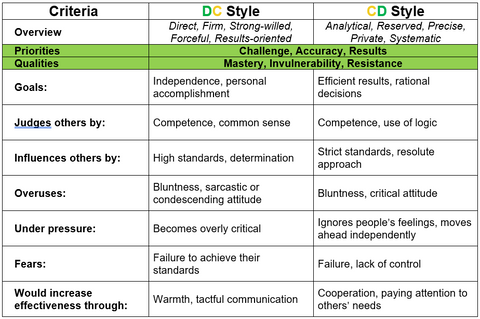DiSC® - Understanding the DC (Dominant / Conscientious) Style
Posted by Bill Harshman on

This lesson continues our increased understanding of not just the four quadrants with which we are already familiar, rather an understanding how changing proximity (distance to a neighboring style) within a particular quadrant yields a result which identifies a separate, unique DiSC® style. Today’s focus is on the DC (Dominant / Conscientious) style.
Where did this come from? As the DiSC® has evolved and become totally computer based, the algorithms showed a much more robust capability to plot your “dot” very specifically within one of the four quadrants. (Our dot simply reminds us of our home base; where we feel most comfortable; our comfy t-shirt.) Research showed that the analysis and weighting of the results placed the same styles in various places within a given quadrant. Simply put, the result was different degrees of the same style and slightly differing preferences and priorities.
What’s in this for the learner?
This lesson will be helpful if you haven’t taken the DiSC®, don’t know your DiSC® style, OR if you are a style other than DC.
Note: Any style with two letters is called a “combined” style. Depending on the sequencing of the “combined” style letters, the first style is more prominent than the second style (e.g., In the case of DC style, the D is the prominent style). As such, in the case of the “combined” DC style, much of the criteria (priorities, qualities, etc.) are reflective of the Dominant quadrant where the DC style resides.
Quick summary of the DC style
Let’s start with what we know. We already know a couple basics about the DC style that reside within the Dominant quadrant. This quadrant - including the DC, D, & Di styles - has a PACE of Faster & Outspoken, combined with an AGREEABLENESS quotient of Questioning & Skeptical (result-focused). And, the brief list of (observable behaviors) descriptors still includes: Direct, Firm, Strong-willed, Forceful, Results-oriented. From our model, we also know that the DC style priorities differ slightly from those of the D & Di styles, and include Challenge, Results, & Accuracy. As we proceed in this lesson, you’ll notice one or more of these priorities identified in our DC candidate. Refer to our blog titled, “EVERYTHING DiSC WORKPLACE® PROFILE - The 8 Priorities“ to understand more about the priorities associated with the DiSC® styles, specifically the DC.
The thrust of this lesson is around the priorities and qualities that tie those aforementioned descriptors together. Let’s begin by examining the DC priorities.

Priorities (listed around the circumference of the model) are the primary areas where people focus their energy depending on their DiSC® style. Everyone has at least three priorities; some have four to five. Having more than three is no better or worse. I’m sharing priorities from the Everything DiSC Workplace® Profile in this example. The Everything DiSC Workplace® priorities are unique to you and based on your results. Priorities simply help us understand how our style might be reflected in motivations and behaviors given real-life work scenarios. The important thing to remember is that when things get foggy (such as when stress or uncertainty appear) we seek the priorities associated with our style.
Priorities of the DC Style: (which are shared with the adjacent CD style)
- Challenge – The DC may seem skeptical and determined, won’t accept ideas without questions, and want to uncover problems that could affect results.
- Results – The DC prefers to deliver quality outcomes efficiently. Usually willing to take charge of projects when necessary and can be counted on to keep things on track.
- Accuracy – The DC prefers to refine their plans before acting to create the best solutions. They tend to avoid letting their emotions get in the way of objective decision-making.
Scales & Qualities
Next, we consider the qualities of the DC style. These are like core needs mentioned in previous articles, however are LESS unconscious and MORE at the surface near conscious, observable behavior. The qualities vary around the model and are represented in scales. The DC scale qualities are Mastery, Invulnerability, & Resistance.

Note: Due to the pairings of styles to form a particular scale, you will notice that these dual-letter designations are shared with their neighboring dual-letter mirror. For example, the DC/CD styles are physically paired together, and as such, they share style qualities. Same is true of the CS/SC proximity, the Di/iD proximity, and the Si/iS proximity. The result is eight DiSC® scales instead of 12 as expected. Thus, we have 12 DiSC® styles contained within 8 DiSC® scales. Though the DC and CD styles are separate and unique, you can consider the DC/CD styles as ONE scale when it comes to qualities. Let’s review the qualities of the DC/CD which include Mastery, Invulnerability, & Resistance.
Qualities of the DC/CD Styles:
- Mastery
- If you ask the DC, they have a strong need for competency with their self-worth being tied to their skills. Critical thinking and common sense are their go-to resources.
- The DC maintains high standards and can show frustration with any level of incompetence around them.
- The DC can seem tenacious and determined to overcome obstacles.
- Invulnerability
- The DC expects life to be tough and usually avoids making themselves vulnerable.
- The DC has a strong sense of self-sufficiency, avoiding reliance on others. They avoid situations that could make them look foolish or incapable.
- The DC may avoid public displays of sentimentality, which can seem manipulative to them.
- Resistance
- The DC tends to be skeptical of their environment and often have a fundamental tendency toward resistance. They are proud of not caving to social pressure or accepting inferior ideas and policies. They resist accepting anything at face value.
- When the DC notices problems, they are among the first to speak up, and are often willing to challenge entire systems that seem inefficient or unfair.
Where the DC and CD styles differ
Up until now, I’ve referred to the neighboring DC/CD styles interchangeably in terms of the overlap of their priorities and their qualities, respectively. HOWEVER, it is important to remember that they ARE two different DiSC® styles. The unique placement of those dots on the DiSC® model is determined by the computer algorithms. I want to share some clarifying / identifying information to help make this distinction clear. The table shows that the two styles share Priorities and Qualities, however differ in terms of their other criteria as determined where their respective dots fell within different quadrants on the DiSC® model.

To some, these differences may seem very subtle, however lumping these two unique styles together as one is inaccurate. One of our Cornerstone Principles shows us that “Each and all 12 DiSC® styles are unique and equally valuable.”
So What?
So, that was a lot of new, detailed, complex information. What do I glean from that and how do I apply meaning to my daily life?
Consider this. There is an implication for leadership. The DC style get 360 feedback from their managers, direct reports, and peers which points to the lowest ratings when it comes to:
- Being approachable
Conversely, the DC style got their highest ratings when it comes to:
- Speaking up about problems or insisting that things be efficient
Let’s also consider some of the assumptions operating within people having the DC style. If you are an DC, see which ones fit for you:
- I’m valuable if I’m competent
- I should always be self-sufficient
- If I’m not in control, I open myself up to disaster
- I should have complete mastery in all areas of my life that are under my responsibility
- It is undignified to show intimate emotions
The “So what?” is for the DC to consider how they would increase their effectiveness. At a glance, the DC tends to have a higher-than-average need for competence and for control. They describe themselves using words like stubborn, determined, logical, and critical. They have been known to be unassailable and will defend even a bad argument to protect their pre-existing beliefs. There is more of a tendency for them to get bored with routine compared to other styles. As such, they are often the people who get things changed. However, this can be a challenge for the DC when major change is facing an organization at a much slower pace than they would prefer. One more thing. The DC can blur the meanings of blunt, honest, diplomatic, and direct. However, each one can have a different nuance and a different implication. Oh, and what about the non-verbals of the DC style? Lots to consider in that DC communication style we’ve used for so long.
This lesson can help the DC to increase effectiveness by accepting and understanding their own style, then incorporating what they know about other styles toward improved communication. I hope this overview increased your awareness, knowledge, and familiarity of DiSC®, especially the DC style. Whether your needs include Onboarding, Employee Engagement, Culture Change, Conflict Management, Team Building, or simply Communication, DiSC® is the research-based, proven, leading training solution. We have several Everything DiSC® assessments to help you craft individual and team solutions.

WORKPLACE®
AGILE EQ™ PRODUCTIVE CONFLICT
WORK OF LEADERS®
MANAGEMENT
SALES
As ALWAYS, the key to effectiveness through DiSC® is understanding your and others’ styles and then using that knowledge for improved interactions.
If you would like a live, complimentary webinar (online) for your team or organization, or if you would like a PDF sample of any of the assessments listed above, please send an email to info@traininglocation.com. If you’d like to purchase the DiSC®, visit DiSC® Classic or Everything DiSC® at our website. And, check out our products from The Ken Blanchard Companies as well.
Share this post
- Tags: Conscientious, DC, Dominant
